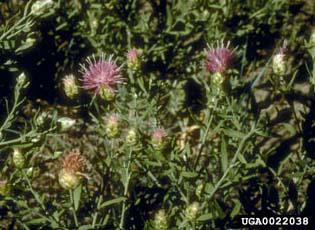Rhaponticum repens (L.) Hidalgo (ITIS)
Russian knapweed, Turkestan thistle, creeping knapweed, mountain bluet, Russian cornflower, hardheads
Centaurea repens (L.), Acroptilon repens (L.) DC. (ITIS)
Eurasia (Zouhar 2001)
Early 1900s (Zouhar 2001)
Accidentally as a seed contaminant (Zouhar 2001)
Crowds out native species and desirable forage; toxic to horses (Zouhar 2001)

Russian knapweed, plants
Photo by Norman E. Rees; USDA, Agricultural Research Service
Find more images
Distribution / Maps / Survey Status
Videos
All Resources
Selected Resources
The section below contains highly relevant resources for this species, organized by source.
Council or Task Force
Partnership
Federal Government
State and Local Government
Academic
Integrated Taxonomic Information System. Rhaponticum repens. [Accessed Sep 22, 2023].
Zouhar, K.L. 2001. Acroptilon repens. In: Fire Effects Information System. U.S. Department of Agriculture, Forest Service, Rocky Mountain Research Station, Fire Sciences Laboratory.
